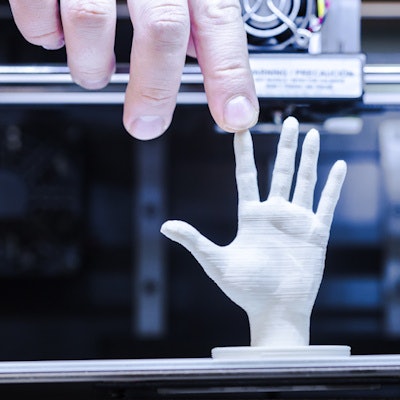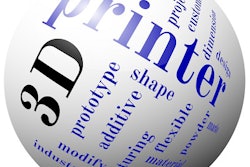
The vision of combining 3D printing and healthcare is now a reality. What can radiologists do to get started, and how can they maximize their role in the field? A panel of 3D printing experts discussed such questions and more in a September 28 webinar.
3D printing is a tremendously exciting technology, but a lengthy string of barriers is hampering its full integration into healthcare, said 3DHeals founder and CEO Dr. Jenny Chen, a neuroradiologist at Stanford University. Fortunately, there are a number of steps radiologists can take to begin bridging the gap, Chen told AuntMinnie.com in an email.
"I would suggest that every radiologist try to print something himself or herself, even if the end point was not useful at first," she said. "Understanding the fundamentals of 3D printing will be critical for any future creative use of the technology."
Current outlook
 Neuroradiologist Dr. Jenny Chen.
Neuroradiologist Dr. Jenny Chen.In an ideal clinical setting, every physician would create a personalized treatment plan -- including pharmaceuticals, implanted devices, and surgeries -- for each patient using tools specifically designed for the physician. This picturesque mode of practice is not yet feasible, but digital health has the potential to drive healthcare along that path, according to Chen.
For example, clinical trials have shown that 3D printing is capable of shortening the amount of time patients spend in the operating room. Reducing time in surgery is a major concern of radiologists, and one that the healthcare 3D printing industry has been focusing on, Chen said.
Furthermore, 3D printing may facilitate communication between physicians and patients.
"A lot of times we have cases where this understanding [of procedures] enables the decision-making process [to be] shorter and makes the patient more satisfied with either their clinical outcome or their decision," she said.
Despite its promise, 3D printing is still struggling to find its place in healthcare due to several obstacles, including variations in cost, technical complexity, a lack of specialized knowledge, a shortage of manpower, and a volatile legal landscape.
"Cost, across the board, no matter what the profession is, is the No. 1 concern. And No. 2 is knowledge," Chen said. "The part that's really hard is knowledge, because how do you educate healthcare providers, administrators, technologists, and engineers?"
Getting started
So, what are some practical measures radiologists can take to get started in 3D printing?
For now, the best way for radiologists new to 3D printing to take the plunge is to educate themselves on the topic, according to Chen. Articles and blogs are available by 3D printing experts, covering subjects ranging from technical techniques, such as segmentation, to business strategies for bringing 3D printing into a hospital environment.
Radiologists seeking to get even more involved can attend events or workshops specifically designed to educate physicians interested in 3D printing:
- RSNA: The annual conference is widely recognized for presenting cutting-edge research and technology in radiology. It has a 3D printing special interest group dedicated to the task.
- 3DHeals: This community aims to help radiologists and healthcare providers as they learn about 3D printing and strive to adopt it in their practices. Its next Global Healthcare 3D Printing Conference, to be held April 20-21 in San Francisco, offers a hands-on workshop and panel discussion.
3D printing courses, albeit a bit more rigorous, can also help radiologists take the next step toward understanding the tool:
- Mayo Clinic's Collaborative 3D Printing in Medical Practice course covers the full scope of 3D printing techniques that have been proved valuable in the clinical setting. The next course is scheduled for February 23-25 in Scottsdale, AZ.
- Massachusetts Institute of Technology's (MIT) Additive Manufacturing: From 3D Printing to the Factory Floor course offers fundamentals on 3D printing. The weeklong course is led by Dr. John Hart, an expert in 3D printing from MIT. Dates for 2018 have not yet been announced; check the website for details.
Optimize locally
Radiologists who are already using 3D printing can optimize their activities by encouraging others to get involved. They are among the handful who can serve as trailblazers for integrating this technology into clinical practice, Chen said. She suggested a few ways to do so locally:
-
Sharing insights. Many people's understanding of 3D printing has been influenced by misleading information, and 3D printing's clinical advances have at times been overshadowed by media hype, Chen said.
Radiologists with real experience can help clarify the role of 3D printing in medicine by providing insight into the matter in public domains or by speaking directly with their peers.
-
Establishing a financial plan. The high cost associated with 3D printing is the chief barrier to bringing it into clinical practice.
"Having a concrete financial strategy to present to the [chief financial officer] of your hospital or practice can have a profound benefit to support your ongoing projects," Chen said. "This is true even if you are not making money for the group immediately based on your analysis. Every investment has intrinsic risk, and the hospitals understand that."
-
Collaborating with others. Many of the 3D-printed simulation models have come from cooperative work between surgeons and radiologists. Increased interaction can help foster communication and thus build relationships between members of a clinical team, according to Chen.
"This also deepens a radiologist's understanding about surgical perspective, potentially making their reports more relevant, which I am sure our surgical colleagues will appreciate," she said.
Information synthesizer
Radiology may play an integral part in increasing the use of 3D printing. The radiologist has long served as the medium between the physical and digital world in healthcare, and now with the assistance of 3D printing, that particular role can be extended to a more profound degree, Chen said.
"I would argue that we should look deeper in our existing role in visualization and dig deeper into what our patients and referring doctors ultimately want: an information synthesizer that can digest digital information in a way that no one else can and provide insights that no one else can," she said.
In these early stages, it is pivotal for physicians interested in bringing 3D printing into healthcare to find and work with a community, and Chen is convinced that many radiologists are up to the task.
"The radiology community has a history of successfully transforming itself by the advancement in technologies," she said. "And I am hopeful that the community will continue to be a leader in using 3D printing to transform healthcare."


















